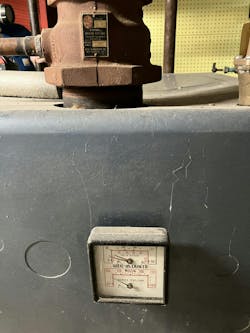Must be ‘63 - Three Boiler Jobs Trapped in Time
Sometimes you just know what year something is from just by looking at it. Take the 1963 Corvette Stingray for example. The car is immediately dated by the split window in the fastback, since it was the only year the Corvette had twin rear glass windows. The look is distinctive and every gearhead that sees on says to himself/herself, “Must be a ‘63”.
Stuck in the '60s
I seemed to be stuck in the ‘60s last week, since most of the job site visits involved replacements for boilers installed in the 1960’s. Of course they were all cast iron boilers, nothing else seems to last 60-plus years. Some looked better than others, depending on the amount of care and attention it received.
The one in the picture was a well maintained residential application. I found out it was a ’63 before we made it to the boiler room. The homeowner told us the house was built in 1963. This installation had all the latest 1963 technology, three zones of heating and all the hydronic accessories of a major Chicago manufacturer.
You can see their version of air separation on the supply pipe leaving the boiler. That’s a dip-tube air separator, located at one of the two points in the system where air is most likely to separate from water, the point of highest temperature. The other point, for you readers that are curious, is the point of lowest pressure.
That point, which is at the top of the system, is usually out of the boiler room. That’s also the place where we have the most problems with radiation that won’t heat because of an air-lock. Coincidence? With the typical 12# static pressure on a cold boiler in the basement, the pressure at the second floor radiation is only going to be about 4#. An exception occurs when the boiler room is not in the basement, but above the radiation in a penthouse.
If you look closely to the gauge in the photo, the static pressure on this boiler is only about 5# at 80 degrees F. Since this is a 1963 model gauge, it reads in feet of altitude as well as pressure. The 5# reading corresponds to 10 feet of altitude, which is on the low side. This '60s house was built on a slab, with one story above. The radiation is less than 10 feet above where the boiler sits, so it should be full of water. I am assuming that it is still accurate.
The copper pipe off the side of the dip-tube air separator is connected to the standard steel expansion tank located in the ceiling of the boiler room, real ‘60s style. The air that separates as the hot water flows out of the boiler floats up to the expansion tank, to maintain that cushion of air needed in the tank.
From Classic to Catastrophic
What I found at the next job was a disaster. It was a church built in the ‘60s, again it was on a slab, no basement. Some of the pipes to feed the radiation were located in the slab, rather than the ceiling. Whenever I run into underground piping, I recommend that the system be checked for leaks. Nobody wants to find out that the underground pipes leak after the new boiler installation. People start getting blamed, and I don’t want to be one of them.
It was going to be tough to check on this job, because there were so many leaks in copper joints and gate valve packing visible in the boiler room. One of the worst leaks was on an automatic air vent right on top of the boiler. Ironically, this vent should never have been located where it was.
By the 1960s, air control became more important. On the end sections, where the supply pipe gets threaded into the section, most manufacturers cast a baffle into the section to act as a built-in air separator. No need to buy that expensive accessory, just pipe the expansion tank to the tapping they provide.
As the water leaves this style boiler, the baffle separates any air in the flow. On this job, the tank was piped properly, but the air vent wasn’t. Since it was on the opposite end section, there was no flow past the baffle and no air separation. The air vent had nothing to vent and eventually did what every automatic air vent does, it leaked. Unfortunately, when I got there it looked like it had been leaking since the turn of the century.
Efficient Refit
The last job in this streak was a boiler in a house built in the 1920s. Sometime in the 60s, the existing boiler was installed. Through the years, the original hand-fired coal boiler was converted to automatic-fired natural gas and the original distribution piping was changed from gravity flow to pump flow. Everything was working fine. The homeowner wanted to know the age of the boiler, get a cost of a new boiler, and how much he could save.
The water piping would easily adapt to a mod-con fire tube boiler and the new flue wouldn’t be too hard. His big interest was energy savings, so I explained how that ton of cast iron under the jacket decreased his efficiency in mild winter weather and how the new mod-con could save him up to 35% or so.
I also asked him how long he was going to live in this house and he gave me a strange look, like he never thought of that. I also reminded him of resale value, and that his house is going to be much more attractive to a potential buyer with a modern high efficiency boiler. He seemed to be absorbing this advice as I was walking back out to my car, to head off to another slice of time.
Patrick Linhardt is a forty-year veteran of the wholesale side of the hydronic industry who has been designing and troubleshooting steam and hot water heating systems, pumps and controls on an almost daily basis. An educator and author, he is currently Hydronic Manager at the Corken Steel Products Co.
About the Author
Patrick Linhardt
Patrick Linhardt is a forty-one-year veteran of the wholesale side of the hydronic industry who has been designing and troubleshooting steam and hot water heating systems, pumps and controls on an almost daily basis. An educator and author, he is currently Hydronic Manager at the Corken Steel Products Co.

